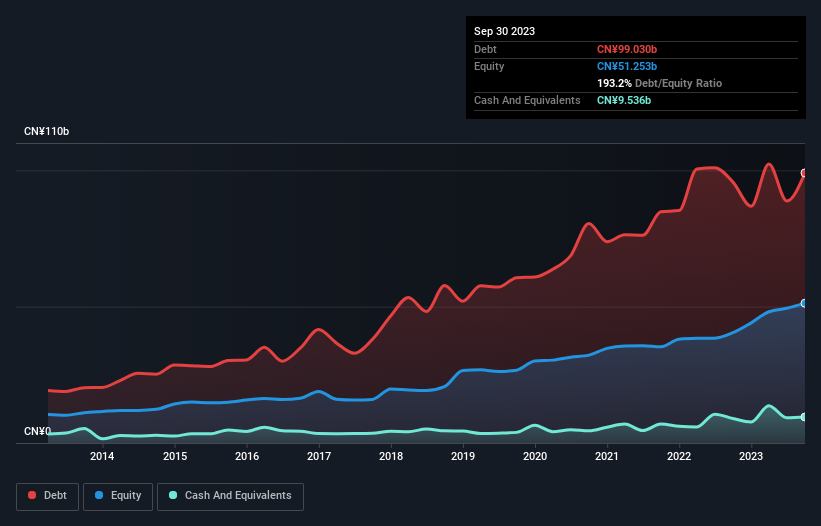- China
- /
- Renewable Energy
- /
- SHSE:600021
Shanghai Electric Power (SHSE:600021) Seems To Be Using A Lot Of Debt

Howard Marks put it nicely when he said that, rather than worrying about share price volatility, 'The possibility of permanent loss is the risk I worry about... and every practical investor I know worries about.' It's only natural to consider a company's balance sheet when you examine how risky it is, since debt is often involved when a business collapses. We can see that Shanghai Electric Power Co., Ltd. (SHSE:600021) does use debt in its business. But the real question is whether this debt is making the company risky.
What Risk Does Debt Bring?
Debt assists a business until the business has trouble paying it off, either with new capital or with free cash flow. Ultimately, if the company can't fulfill its legal obligations to repay debt, shareholders could walk away with nothing. However, a more frequent (but still costly) occurrence is where a company must issue shares at bargain-basement prices, permanently diluting shareholders, just to shore up its balance sheet. Having said that, the most common situation is where a company manages its debt reasonably well - and to its own advantage. The first thing to do when considering how much debt a business uses is to look at its cash and debt together.
See our latest analysis for Shanghai Electric Power
How Much Debt Does Shanghai Electric Power Carry?
The chart below, which you can click on for greater detail, shows that Shanghai Electric Power had CN¥99.0b in debt in September 2023; about the same as the year before. On the flip side, it has CN¥9.54b in cash leading to net debt of about CN¥89.5b.

A Look At Shanghai Electric Power's Liabilities
According to the last reported balance sheet, Shanghai Electric Power had liabilities of CN¥43.9b due within 12 months, and liabilities of CN¥73.9b due beyond 12 months. Offsetting this, it had CN¥9.54b in cash and CN¥23.0b in receivables that were due within 12 months. So it has liabilities totalling CN¥85.2b more than its cash and near-term receivables, combined.
This deficit casts a shadow over the CN¥23.7b company, like a colossus towering over mere mortals. So we definitely think shareholders need to watch this one closely. After all, Shanghai Electric Power would likely require a major re-capitalisation if it had to pay its creditors today.
We measure a company's debt load relative to its earnings power by looking at its net debt divided by its earnings before interest, tax, depreciation, and amortization (EBITDA) and by calculating how easily its earnings before interest and tax (EBIT) cover its interest expense (interest cover). Thus we consider debt relative to earnings both with and without depreciation and amortization expenses.
Shanghai Electric Power has a rather high debt to EBITDA ratio of 6.7 which suggests a meaningful debt load. But the good news is that it boasts fairly comforting interest cover of 2.7 times, suggesting it can responsibly service its obligations. However, it should be some comfort for shareholders to recall that Shanghai Electric Power actually grew its EBIT by a hefty 129%, over the last 12 months. If it can keep walking that path it will be in a position to shed its debt with relative ease. When analysing debt levels, the balance sheet is the obvious place to start. But it is future earnings, more than anything, that will determine Shanghai Electric Power's ability to maintain a healthy balance sheet going forward. So if you're focused on the future you can check out this free report showing analyst profit forecasts.
Finally, while the tax-man may adore accounting profits, lenders only accept cold hard cash. So it's worth checking how much of that EBIT is backed by free cash flow. During the last three years, Shanghai Electric Power burned a lot of cash. While that may be a result of expenditure for growth, it does make the debt far more risky.
Our View
To be frank both Shanghai Electric Power's conversion of EBIT to free cash flow and its track record of staying on top of its total liabilities make us rather uncomfortable with its debt levels. But at least it's pretty decent at growing its EBIT; that's encouraging. We're quite clear that we consider Shanghai Electric Power to be really rather risky, as a result of its balance sheet health. So we're almost as wary of this stock as a hungry kitten is about falling into its owner's fish pond: once bitten, twice shy, as they say. When analysing debt levels, the balance sheet is the obvious place to start. However, not all investment risk resides within the balance sheet - far from it. For example - Shanghai Electric Power has 1 warning sign we think you should be aware of.
If you're interested in investing in businesses that can grow profits without the burden of debt, then check out this free list of growing businesses that have net cash on the balance sheet.
New: Manage All Your Stock Portfolios in One Place
We've created the ultimate portfolio companion for stock investors, and it's free.
• Connect an unlimited number of Portfolios and see your total in one currency
• Be alerted to new Warning Signs or Risks via email or mobile
• Track the Fair Value of your stocks
Have feedback on this article? Concerned about the content? Get in touch with us directly. Alternatively, email editorial-team (at) simplywallst.com.
This article by Simply Wall St is general in nature. We provide commentary based on historical data and analyst forecasts only using an unbiased methodology and our articles are not intended to be financial advice. It does not constitute a recommendation to buy or sell any stock, and does not take account of your objectives, or your financial situation. We aim to bring you long-term focused analysis driven by fundamental data. Note that our analysis may not factor in the latest price-sensitive company announcements or qualitative material. Simply Wall St has no position in any stocks mentioned.
About SHSE:600021
Shanghai Electric Power
Engages in the integration of clean energy, new energy, smart energy technology research and development and application, modern energy supply, and services in China and internationally.
Average dividend payer and slightly overvalued.
Similar Companies
Market Insights
Community Narratives




